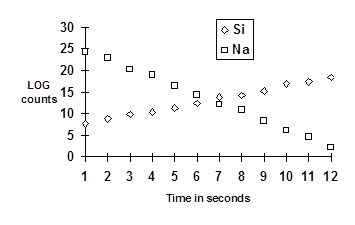Time Dependent Intensity (TDI) Element Corrections
It is well known that measurements of x-ray intensity in glass matrices of certain elements, such as Na and K, show a sharp drop off in count rate under normal beam currents (10 or 20 nA). This has been traditionally referred to as "volatile element" behavior. This is not strictly correct for all of the elements involved, and we will instead introduce and use the phrase Time Dependent Intensity (TDI) element behavior, since current technical explanations suggest electron implantation in insulators (static charge layers) and/or heating cause migration of atoms either deeper into the material, or out of the sample into the vacuum (C. E. Linebarger J. Am. Chem. Soc., 1895, 17 (8), pp 615–652). The intensity loss (or gain) appears to be instantaneous as seen in this glass for 2 separate measurements of Na Ka:


Note however, the slight curvature in the Lin-Log plot above (right hand side). This curvature in log space may indicate two separate exponential processes with different time constants overlapping in time. The “hyper-exponential” TDI correction described below is utilized to deal with this situation.
There are several ways to minimize this effect (lower beam current, defocus beam), but they may not be useful in certain analytical circumstances requiring both sensitivity and high spatial resolution.
Coincident with the effective loss of one element, there may be an increase in x-ray counts of other elements in the material (such as Si and Al), referred to as "grow in" (Morgan and London, 1996) as seen in the plot below. This is probably due to a decreasing matrix absorption effect for less mobile elements such as Si and Al, that, as the more mobile elements such as Na and K migrate to greater depths attracted by the sub-surface electron charge, the emission intensity of the Si and Al increases over time.
The TDI correction generally assumes that the change in counts is linear versus time when the natural LOG of the x-ray counts are plotted (Nielsen and Sigurdsson, 1981) as shown here :

Note that one can significantly reduce the time delay between when then beam is first unblanked and the x-ray counting is started by using the “Synchronous” option in the Acquisitions Option dialog. This is especially useful for the Time Dependent Intensity (TDI) acquisition modes when the sample is extremely sensitive to intensity change during the first few seconds of beam exposure.
Probe for EPMA offers a Time Dependent Intensity (TDI) element extrapolation, whereby a short time series of measurements are made for the element(s) in question. This can be done for both the Time Dependent Intensity (TDI) element and any grow-in elements, as well as for other situations where X-ray intensity changes during beam irradiation, e.g. carbon contamination, beam damage, etc. This correction is useful for samples that are too small to utilize a defocused beam, and allows the user to apply higher beam currents to improve the analytical sensitivity.
Two different methods are utilized by Probe for EPMA to correct for Time Dependent Intensity (TDI) element behavior: the first is an assigned method where an unknown sample is acquired and then later assigned for use as a calibration curve for one or more samples. The other is a "self" calibration where intermediate intensities are saved as the data is acquired and later used as the basis for calculating the Time Dependent Intensity (TDI) correction.